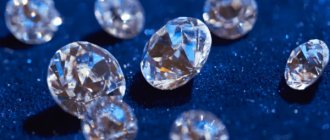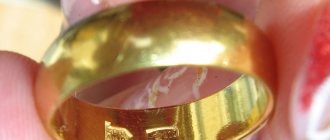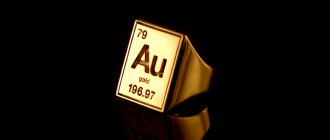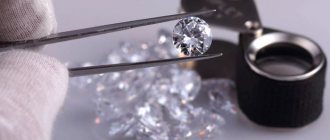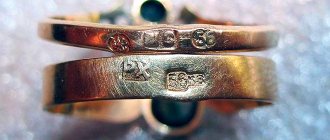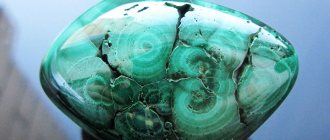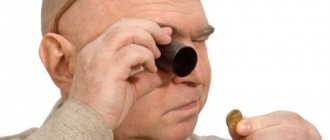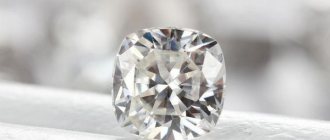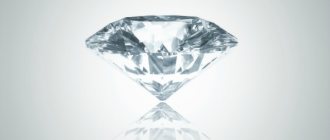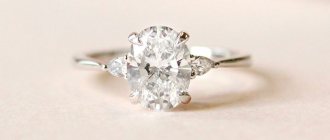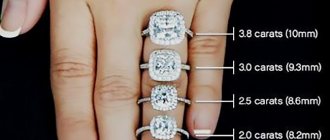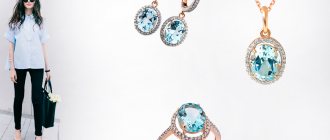You don't need to be a jeweler with years of experience to learn how to determine the carat value of a diamond. A general knowledge of the measurements is enough to find out how many carats are in any real diamond you have purchased if you suddenly have doubts about the integrity of the seller. And the diamond carat table will tell you what a diamond looks like if its weight is accurately determined to be 1 carat, and the sizes of diamonds of the corresponding weight.
Where is the best place to choose diamonds?
As a rule, it is recommended to purchase precious stones in jewelry stores. This way, you can assess the quality of the stone in a relaxed atmosphere, and, if necessary, look at the gemological certificate, which contains data on weight, clarity, type of cut and other parameters. In addition, if you suddenly have complaints about the quality of a gemstone, you can contact the salon and sort out the problem.
Some people choose stones from specialized online stores or at auctions. But, before making any online purchase, read reviews about a particular online site and thoroughly study the history of the company.
How to choose a diamond according to characteristics
Diamonds are used to set rings, bracelets, pendants and other jewelry. You can also purchase a gemstone separately, for example, to set it in a piece of jewelry made to order.
If you don't know how to choose diamonds when purchasing, a diamond certificate can help you. It is issued for all diamonds of natural origin and weighing from 0.29 carats. A document confirming the authenticity of stones is issued, for example, by the Gemological Center of Moscow State University and the Russian Gemological Laboratory, as well as various international organizations such as GIA, HRD Antwerp. The certificate contains:
· information about the manufacturer;
· Name of product;
date of manufacture, dimensions of the stone;
· type and grade of frame material;
· type and quality of cut.
Before choosing diamonds, read the certificate. Also consider a number of other characteristics.
Carat
The weight of diamonds is measured in carats (ct). One carat is equal to 0.2 g. This is how much one carob seed, which grows in the Middle East and the Mediterranean, weighs. Diamonds are divided into three types based on carat content:
· small - 0.29 ct or less;
medium - from 0.3 ct;
· large - from 0.7 ct.
As a rule, jewelers encrust rings and rings with large diamonds, while smaller options are chosen for earrings, brooches and other jewelry.
It is worth understanding that the weight of a gemstone does not always correlate with its size, but the price of stones of different categories can vary greatly. Thus, stones weighing 0.99 carats visually look the same as one-carat diamonds, but are slightly cheaper than the latter.
Pavilion depth in percentage
Percent Pavilion Depth is the depth of the diamond's pavilion, measured from the culet to the intersection of the pavilion and girdle, in relation to the average girdle diameter, expressed as a percentage. Recorded to the nearest half percent (0.5%).
The average pavilion depth percentage is a calculated value obtained from the following formula:
Pavilion depth% = (average pavilion depth ÷ average girdle diameter) x 100
Cut
Its brightness and appearance depend on the quality of stone processing. The type of cut and the accuracy of the angles determine the brilliance and beauty of a diamond. The quality of the cut is assessed on a letter scale:
· A - higher;
· B - good;
· B - average;
· G - low.
If you decide to choose a diamond ring or earrings, an important characteristic will be the cut shape. The classic version is considered to be a round cut with 57 facets. Stones cut in the shape of a heart, drop, square, rectangle or oval look original.
Total depth in percentage
The overall percentage depth of a round brilliant is the ratio of the distance from the table to the culet to the average diameter of the girdle, expressed as a percentage to the nearest tenth of a percent (0.1%).
The total percentage depth is a calculated value obtained using the following formula:
Total depth % = (depth ÷ average girdle diameter) x 100
Color
Colorless stones
Transparent stones are considered the most valuable. Colorless diamonds are divided into nine groups. The first group includes absolutely transparent stones, and the ninth group includes brownish or visible yellowish stones. Stones of groups 3–5 are considered popular. There is also a letter-based international classification, in which the color of stones is distributed from D to Z.
It is impossible to visually notice the difference between the stones of the third and fourth, as well as the fourth and fifth groups. At the same time, the difference in price is quite noticeable. Therefore, when the question is which diamond to choose, the decision depends on whether you are willing to overpay.
Colored stones
The cost of colored diamonds is affected by the brightness and saturation of the hue. Most often, colored options are cheaper than colorless ones, but there are exceptions. Thus, stones of the so-called fancy colors can be more expensive than the most transparent samples.
Purity
Before choosing jewelry or stones separately, consider not only the carat value, but also the clarity of the diamonds. The radiance of stones is determined by their ability to transmit light rays: the lower the purity index, the less pronounced their shine.
Absolutely pure stones without any inclusions are quite rare, which affects their cost. Such samples are often sold without frames, and they are subject to mandatory certification. To assess the clarity of diamonds, there is an international scale consisting of 11 levels: from IF - an absolutely pure stone, to I3 - a diamond with defects and inclusions.
The Russian classification provides:
· for small stones - 9 purity groups;
· for large ones - 12 purity groups.
Perfectly clear diamonds receive a 1, while those with noticeable and/or numerous inclusions receive a 12.
If your goal is to choose diamond jewelry for beauty and not for investment, take a closer look at diamonds that belong to groups 3–4 in color and 1–7 in clarity. As a rule, it is better not to purchase stones of levels 9–12 - due to numerous defects, they often split and do not look very attractive.
Painting
The term "painting" refers to the inclination of the upper or lower half-facets in relation to the main upper and lower facets, resulting in more subtle "hilly" positions where the main facets of the crown and pavilion meet. If this angle of inclination decreases, approaching the angle between the main faces, then the visual difference between them is blurred.
The top illustration shows the picture on the crown, the bottom one shows the picture on the pavilion.
How to choose diamond jewelry: criteria for determining quality
Each piece of jewelry is attached with a tag indicating its characteristics. The same applies to large expensive diamonds that are sold without a setting. Let's look at an example of how to read a tag. Let's say we see the following: 5 KR-57 0.7 2/2 B.
What does it mean:
· 5 - the total number of diamonds in the jewelry;
· KR - cut shape, in our case, round;
· 57 — number of faces;
· 0.7 - the weight of one stone or the total weight of all stones in the decoration;
· 2/2 – color and clarity of diamonds on a scale from 1 to 9;
· B—cut level.
What to remember when buying a diamond
A professional gemologist or jeweler will help you choose the right jewelry. But since it is not always possible to take a knowledgeable person with you, it is advisable to remember several points:
· Decide on your purchasing budget. Consider how much you are willing to spend on a piece of jewelry or gemstone.
· Select several options, compare them with each other based on their main characteristics.
· Choose the product that best suits your price and quality.
· When purchasing a diamond, pay attention to the certificate - it must contain a detailed description of the stone’s parameters.
Experts recommend choosing jewelry with stones that have average gemological indicators - in the range from 3 to 5 (on a scale of purity, color). Such diamonds look decent in jewelry, and their cost is not prohibitively high.
Crown height in percentage
Crown percentage height is the distance measured from the landing to the point of intersection of the main facet of the crown with the girdle chamfer in relation to the average diameter of the girdle, expressed as a percentage. Recorded to the nearest half percent (0.5%).
The percentage crown height is a calculated value obtained using the following formula:
Crown height% = (average crown height ÷ average girdle diameter) x 100
How to distinguish natural stone from synthetic
Artificially grown diamonds are similar in physical and optical characteristics to natural ones. They are almost completely identical, except that synthetic stones are created in laboratory conditions.
Experts will help you accurately determine the origin of a gemstone. It is also quite possible to independently verify the authenticity of a diamond: for this you will need an ultraviolet lamp. Under the influence of ultraviolet light, natural stones glow with a light blue hue. Synthetic counterparts will typically have a yellow or green cast.
How to choose the right diamond ring
When purchasing a diamond ring, consider the size of the piece as well as the shape of your hands and fingers. So, for those with large palms and long fingers, rings and washer rings with large stones are suitable. On petite hands with thin fingers, round and flat rings with several small diamonds will look good.
Focus on your own taste and financial capabilities. If you are purchasing jewelry as a gift, ask about the wishes of the person you plan to give it to.
To choose the right diamond ring, consider a number of characteristics:
· Type of cut. A classic round cut would be a universal option, but jewelry with inserts of other shapes looks no less impressive: “Marquis”, “Heart”, “Princess”, “Drop”, etc.
· Frame material. Platinum, white or yellow gold are usually chosen as the setting for a diamond.
· Weight of decoration. It is good when the product into which the stone is inserted does not look too fragile. Thus, diamonds look quite harmonious in jewelry weighing at least two grams.
· Condition of inserts. Inspect the stones in the ring with a magnifying glass - there should be no scratches, chips or other visible defects on the inserts.
An equally important parameter when choosing is the type of stone fastening. The way the diamond is set determines the design and appearance of the ring. In addition, it depends on how securely the gemstone is fixed in the jewelry.
There are several options for setting diamonds:
· deaf, partially deaf;
· speckled, fadenovaya;
· corner, pavé;
· carmesine, teak;
· invisible.
Buy rings only from jewelry stores that have a reliable reputation in the market. When choosing products with large diamonds, study the certificate of authenticity of the stones.
Home testing methods
You can check a diamond at home if you study simple but time-tested methods in advance.
- The integrity of gemstone crystals is tested using water. Clean water will make the joining lines of parts visible when counterfeiting.
- Warm. A true diamond heats up slowly. Cooling, on the contrary, occurs instantly. You can conduct a simple experiment that will allow you to distinguish a fake: the sample being tested is heated over low heat, then suddenly dropped into cold water. The synthetic stone will become covered with cracks, but nothing will happen to the diamond.
- Reaction to breathing. The test is based on studying the behavior of the diamond. They begin to breathe on the stone so that it fogs up. A real crystal cannot attract heat. Humidity and air vapor have nothing to cling to. The fake one shows condensation and moisture. This is often done right in the jewelry store. The way to identify a diamond is not always accurate. Zirconium and moissanite behave similarly to natural samples.
- Fat. Any liquid with fat (vegetable oil) is dripped onto the earrings, then applied to the glass surface. The real mineral will combine with the glass, and an oil stain will not change the original shape. There is no such thing on a fake, here drops of fat will spread into small parts. Jewelers work with the rock only with gloves, so as not to spoil the surface with greasy hands.
- Laser radiation. A beam is directed at the pendant with the stone; something like a rim should appear on the back side. The beam seems to flow around the diamond. It cannot pass through the true pattern.
- Ultraviolet radiation. Most products change their light under a lamp. It turns blue. If there is no glow, then it is either a high quality diamond or a cheap fake. Fraudsters have invented a way for artificial samples to glow blue.
- Emery. The most dangerous and undesirable method of verification. The stone is rubbed with sandpaper. A fake will immediately get scratches. Sandpaper with diamond chips will damage the surface and the real crystal. You can ruin an acquisition without understanding whether the item you purchased is the real thing. This is how they try to distinguish it from sapphire.
- Comparison with real stones. If your collection contains jewelry with real sapphires or rubies, you can try to scratch the surface of the sample being tested with them. Diamond has a higher hardness index, so no marks will remain on the real material. But there is a danger that the crystal will break, since it does not like pressure and turns out to be fragile.
- Exposure to acid. Hydrochloric acid is unable to do anything to a diamond. Most imitations are afraid of its properties and lose their shape, shine, and beauty.
Before you start checking, you should think about whether you can contact a specialist to find a safer option for the product. Even a fake can be a good purchase for someone. It is better to stop the deception in time, and not spoil the work of the craftsmen.
